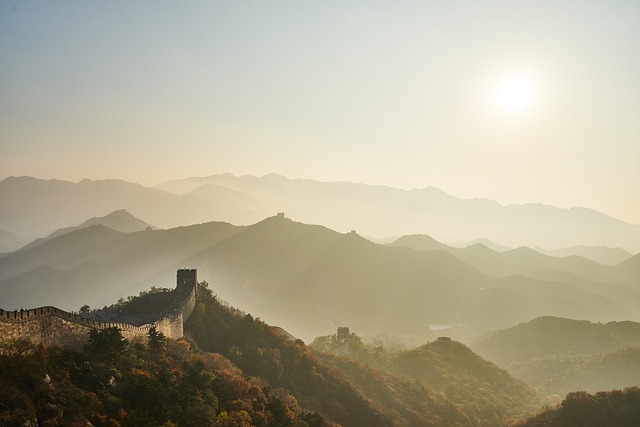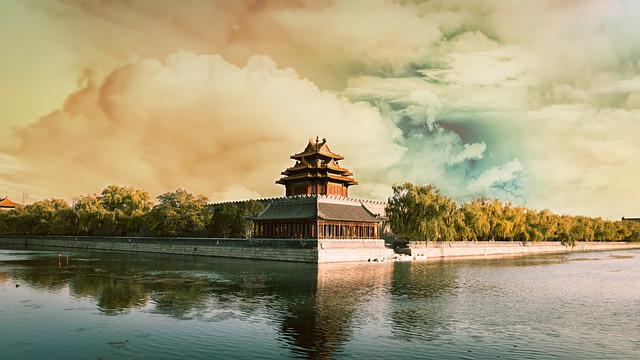The Great Wall of China, an iconic symbol of architectural prowess and a testament to human endeavor, stretches across thousands of miles with its ancient ramparts defying the passage of time. This article delves into the multifaceted history, cultural significance, and enduring legacy of one of the most remarkable feats of engineering in world history. From the unification of disparate military defense systems to its role as a beacon of national pride, the Great Wall has stood as both a protective barrier against invaders and as a vibrant cultural icon whose influence permeates Chinese folklore. As we traverse through its storied past, we will explore the construction timeline that spans centuries, the conservation efforts that aim to preserve this wonder for future generations, and the ingenious techniques employed by ancient Chinese builders that continue to inspire modern architects and engineers. Join us as we unravel the layers of history encapsulated within the stones and mortar of the Great Wall of China.
- 1. Ancient Marvel: Exploring the Enduring Legacy of the Great Wall of China
- 2. Milestones and Stretches: The Construction Timeline of the Great Wall of China
- 3. Cultural Icon: The Significance of the Great Wall in Chinese History and Folklore
- 4. Protecting Antiquity: Conservation Efforts for Preserving the Great Wall Through Ages
- 5. Engineering Wonder: Innovations and Techniques Used in Building the Great Wall of China
1. Ancient Marvel: Exploring the Enduring Legacy of the Great Wall of China

1. For over two millennia, the Great Wall of China has stood as a testament to human ingenuity and ambition. This colossal fortification stretches an astounding 21,000 kilometers from Dandong in the east to Lop Lake in the west, traversing various terrains including harsh deserts, dense forests, and steep mountains. The Wall’s construction was initiated under the first Emperor of China, Qin Shi Huang, in the 3rd century BCE, with subsequent emperors and dynasties adding to its length and fortifications over the centuries that followed. The Wall’s purpose has evolved from a military defense system against northern invaders to a symbol of national pride and an attraction for visitors from around the globe. Its scale and the sheer number of watchtowers, barracks, garrison stations, and signal communications systems along its route are indicative of the meticulous planning and strategic foresight that went into its construction. The Great Wall’s enduring legacy is a reflection of the historical periods it spans, the diverse cultures it represents, and the unified spirit it embodies, making it one of the most remarkable feats of human engineering in history.
2. Beyond its immediate impression as an architectural wonder, the Great Wall holds profound significance in the cultural and historical narrative of China. It is a living museum, where each section tells a different story about the era of its construction. The Wall’s segments vary in condition, with some sections well-restored and others lying in ruins, yet all are steeped in history. The Wall has been depicted in countless artworks and literature, serving as a motif that transcends time. It is also a subject of scientific research, offering insights into ancient building techniques, environmental conditions during different periods, and even astronomy, as evidenced by the alignment of some watchtowers with celestial bodies. The Great Wall’s influence extends beyond its geographical boundaries, shaping international perceptions of China and its historical continuity. It is a site that not only connects the past but also continues to forge connections among people from various backgrounds who come to marvel at its grandeur.
2. Milestones and Stretches: The Construction Timeline of the Great Wall of China

The construction of the Great Wall of China is an epic chronicle of human endeavor spanning over two millennia. The earliest segments of the wall were built as early as the 7th century BC during the Spring and Autumn period by various states as fortification against northern nomads. The most famous sections attributed to Emperor Qin Shi Huang, who unified China in 221 BC, are those that form the backbone of the wall we recognize today. His command to connect and standardize these disparate walls was a monumental task that involved moving millions of laborers and conscripted soldiers to carry out the construction. This initial phase of standardization was completed by around 200 BC.
Subsequent emperors expanded and fortified the wall to protect their dynasties. The Han Dynasty (206 BC – 220 AD) extended the wall’s western reaches towards the oasis cities of Dunhuang and Jiayuguan, making it an effective barrier against invasions from the west. During the Ming Dynasty (1368–1644), faced with increased threats from the north, they built the most extensive sections of the wall. The Ming builders incorporated advanced military technologies, such as watchtowers equipped with signal-firing devices to communicate along the wall. This period saw the construction of the iconic beacon towers and the fortifications that stretched across diverse terrains from harsh deserts to rugged mountains. The wall’s timeline is thus a testament to the changing threats, technological advancements, and the adaptive measures taken by successive Chinese regimes to defend their borders over centuries.
3. Cultural Icon: The Significance of the Great Wall in Chinese History and Folklore

The Great Wall of China transcends its physical existence as a monumental feat of engineering; it is deeply ingrained in the cultural fabric of China, serving as a potent symbol that resonates with a sense of national pride and identity. Throughout Chinese history, the Wall has been a repository of cultural narratives, myths, and legends that have shaped the collective consciousness of the Chinese people. It features prominently in folklore, where it is often depicted as a protector against the forces of chaos and destruction, embodying the indomitable spirit of the Chinese people. The Wall’s representation in literature and art has reinforced its symbolic value, with characters like the mythical General Xuanyuan leading soldiers to repel invaders atop its ramparts. This cultural icon has become a metaphor for resilience and fortitude, reflecting the nation’s enduring legacy and historical struggles.
Moreover, the Great Wall has been celebrated in Chinese history as a testament to the country’s engineering prowess and strategic acumen. It is a physical embodiment of the harmonious relationship between humans and their environment, showcasing how ancient China harnessed natural terrain to defend its borders. The Wall’s construction spanned over two millennia, with various dynasties contributing to its length and strength, each leaving an indelible mark on this enduring structure. It is not merely a series of fortifications but a living chronicle of the Chinese civilization’s evolution, encompassing different eras and empires. As such, it stands as a cultural icon that embodies the collective memory of China, a beacon of historical continuity, and an inspiration for future generations to draw upon as they navigate their own paths in a rapidly changing world.
4. Protecting Antiquity: Conservation Efforts for Preserving the Great Wall Through Ages

Throughout its storied history, the Great Wall of China has been subject to various environmental, structural, and human impacts that have necessitated proactive conservation efforts. The passage of time, weathering elements, and the ravages of war have all taken their toll on this monumental edifice. However, it is the relentless encroachment of nature that poses one of the most significant challenges to the Wall’s preservation. Plant roots from encroaching vegetation can undermine the foundations; wind and rain erode the stones and bricks; and the dynamic interplay between moisture and temperature cycles causes structural stress. To counteract these forces, conservationists have implemented a multi-faceted approach that includes physical stabilization, environmental monitoring, and public education. Techniques such as anchoring, repairing, and reinforcing key sections of the Wall with traditional materials are employed to ensure its integrity is maintained without altering its historical character. Regular maintenance is conducted to prevent the ingress of vegetation and to manage the effects of tourism, which has become one of the most pressing threats due to the sheer number of visitors traversing the Wall each year.
The preservation of the Great Wall is not only a matter of safeguarding a UNESCO World Heritage site but also an endeavor that reflects the cultural identity and heritage of China. As such, conservation efforts are guided by principles that respect both the historical significance and the natural environment in which it exists. The integration of advanced technology, including satellite imaging and thermal scanning, has allowed for more precise monitoring of the Wall’s condition and the environmental factors affecting its preservation. Moreover, the involvement of local communities in the conservation process has ensured that the economic benefits derived from tourism are balanced with the imperative to preserve this wonder for future generations. These efforts underscore a global recognition of the Great Wall’s importance not only as an architectural marvel but also as an integral part of human history, and they represent a commitment to its enduring legacy.
5. Engineering Wonder: Innovations and Techniques Used in Building the Great Wall of China

The construction of the Great Wall of China is an engineering marvel that stands as a testament to human ingenuity and resilience. Its sprawling lengths, stretching across thousands of miles, were built over several dynasties, each contributing unique techniques and innovations to this monumental task. The early stages of wall-building involved simple earthen walls constructed during the Spring and Autumn (770–476 BCE) and Warring States (475–221 BCE) periods to defend various states from nomadic invasions. However, it was under Emperor Qin Shihuang that the first unified effort to connect these sections into a single fortification began. His engineers utilized rammed-earth technology, which involved compacting layers of soil and gravel into sturdy foundations, a method still recognized for its durability and strength.
The subsequent Ming Dynasty (1368–1644) saw the most extensive construction of the Great Wall, with advancements in military architecture leading to more elaborate fortifications. The Ming builders introduced brick and stone masonry, which not only provided a solid defense against invading forces but also facilitated the deployment of troops along the wall. They innovated with watchtowers spaced at regular intervals, allowing for surveillance and communication across vast distances using smoke signals or beacon towers. These towers were strategically placed every 500 to 1,000 paces, enabling rapid transmission of messages over hundreds of miles within a day. The wall’s alignment with natural terrain features such as mountain ridges and valleys was also a deliberate strategy, leveraging the landscape’s natural defenses and blending human engineering with the environment. This integration of topographical awareness and architectural innovation made the Great Wall an imposing barrier that remained a symbol of China’s defense for centuries to come.
